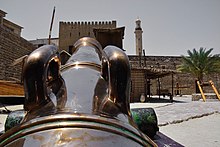Handle (gun)
The handle (often also called the dolphin ) is a component on the gun barrel . The handles were used as suspension points to lift the gun barrel into or out of the mount . For this purpose, a lifting tree , rope or chain was passed through the handle and the gun barrel could be raised and lowered using a lifting device with a winch .
The name dolphin comes from the fact that the handles often had the decorative shape of dolphins . As a rule, care was taken to ensure that the underside of the handle was smooth so that the carrying rope was not chafed through.
With cannons and howitzers , which were more horizontal in the mount, the handles were arranged above the center of mass . In the case of mortars, however , the handles were attached in front of the center of mass because mortars were set up more vertically. In order not to obscure the line of sight , cannons and howitzers had two handles on either side of the line of sight. This was not necessary for mortars that were aimed indirectly as deep fire guns , and therefore some mortars only had one handle. The handles were first modeled separately from the model of the gun barrel and attached to it using the lost wax technique before casting .
Small gun barrels had no handles because they were light enough to be lifted without their help. The handles were only attached to gun barrels made of bronze . Cast iron wasn't strong enough for the purpose; they were left out of wrought iron and cast steel because they made difficulties in the manufacture of the gun barrel.
From the middle of the 19th century , the handles became rarer. The reason was a gradual switch to cast steel as the pipe material. In the case of heavy gun barrels without a handle, tools such as sling bars were used, which gripped the barrel before and after the center of mass.
Individual evidence
- ↑ a b c d e Andreas Rutzky: The establishment and construction of the rifled guns. Markgraf Verlag, 1864, pp. 204-205, Google Books
- ^ Joseph Hütz: Handbook of the Royal Bavarian Artillery, Volume 2 , Verlag Franz, 1861, pp. 1047-1049, Google Books
- ↑ a b Geschütz in: Allgemeine Encyclopädie der Wissenschaften und Künste , 1st Section, Volume 63, 1856, p. 120, Google Books
- ↑ Josef Reister: Elementary weapons training for the use of the Imperial and Royal regiment preparation and cadet schools, as well as for one year olds. Volunteers, Edition 5 , Verlag Schimpff, 1874, p. 178, Google Books
- ↑ a b c Otto Maresch: Waffenlehre für officers of all weapons , 1875, p. 136, Google Books
- ^ Heinrich Ferdinan Kameke: Explanations on the collection of lithographic drawings: The gun barrel and the objects for making and examining the same, Volume 5, Verlag Nauck, 1837, p. 37, Google Books
- ^ Gun foundry in: General German Conversations Lexicon for the educated of every class, Volume 4 , Verlag Gebrüder Reichenbach, 1840, p. 545, Google Books
- ↑ Georg Ortenburg: Weapons of the Wars of Unification 1848–1871 , Bechtermünz, 2005, original 1990, ISBN 3828905218 , p. 85


